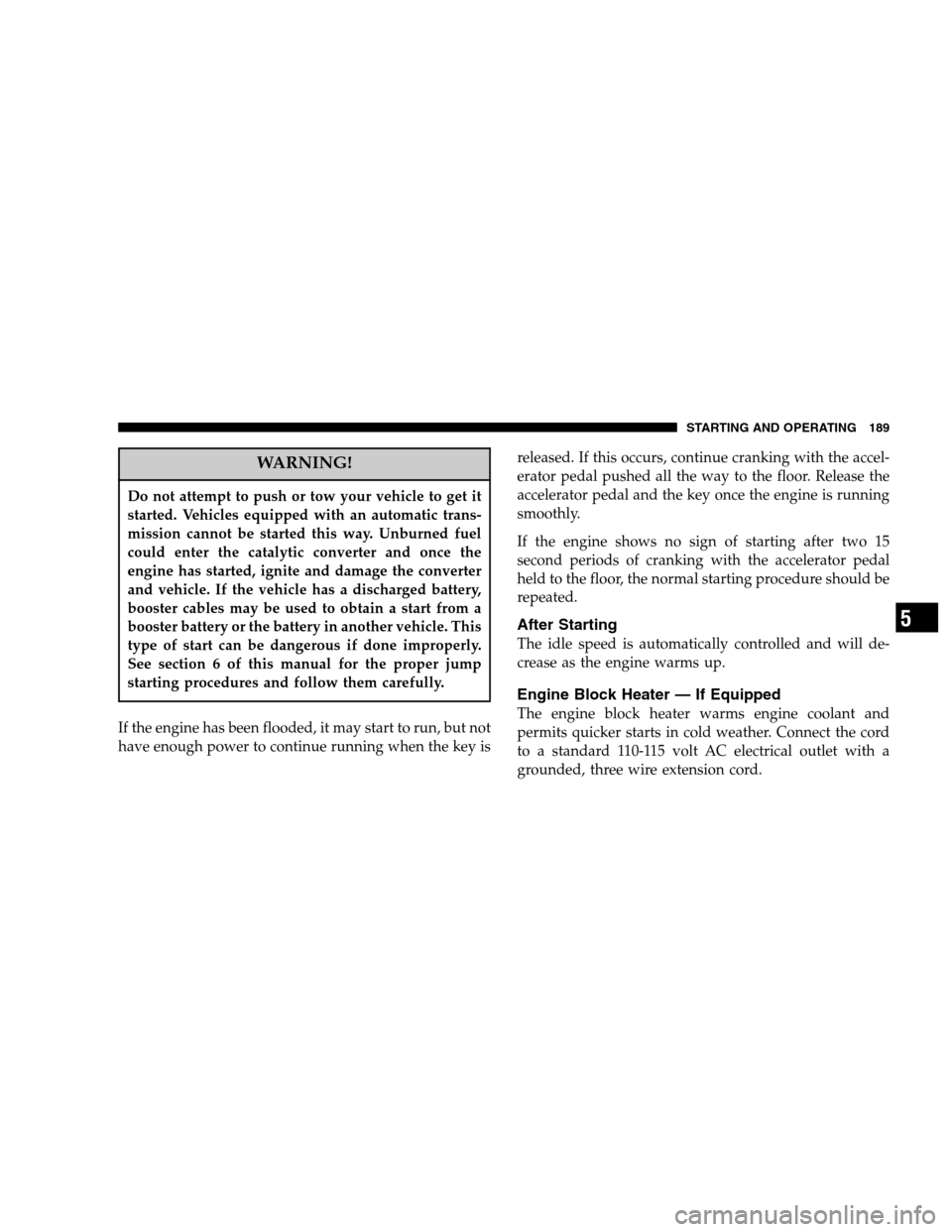2007 DODGE DAKOTA fuel type
[x] Cancel search: fuel typePage 189 of 400

WARNING!
Do not attempt to push or tow your vehicle to get it
started. Vehicles equipped with an automatic trans-
mission cannot be started this way. Unburned fuel
could enter the catalytic converter and once the
engine has started, ignite and damage the converter
and vehicle. If the vehicle has a discharged battery,
booster cables may be used to obtain a start from a
booster battery or the battery in another vehicle. This
type of start can be dangerous if done improperly.
See section 6 of this manual for the proper jump
starting procedures and follow them carefully.
If the engine has been flooded, it may start to run, but not
have enough power to continue running when the key isreleased. If this occurs, continue cranking with the accel-
erator pedal pushed all the way to the floor. Release the
accelerator pedal and the key once the engine is running
smoothly.
If the engine shows no sign of starting after two 15
second periods of cranking with the accelerator pedal
held to the floor, the normal starting procedure should be
repeated.
After Starting
The idle speed is automatically controlled and will de-
crease as the engine warms up.
Engine Block Heater — If Equipped
The engine block heater warms engine coolant and
permits quicker starts in cold weather. Connect the cord
to a standard 110-115 volt AC electrical outlet with a
grounded, three wire extension cord.
STARTING AND OPERATING 189
5
Page 227 of 400

2. Economy—
Improper inflation pressures can cause uneven wear
patterns to develop across the tire tread. These abnormal
wear patterns will reduce tread life resulting in a need for
earlier tire replacement. Under inflation, also increases
tire rolling resistance and results in higher fuel consump-
tion.
3. Ride Comfort and Vehicle Stability—
Proper tire inflation contributes to a comfortable ride.
Over inflation produces a jarring and uncomfortable ride.
Tire Inflation Pressures
The proper cold tire inflation pressure is listed either on
the face of the driver’s door or on the driver’s side “B”
pillar.
Some vehicles may have Supplemental Tire Pressure
Information for vehicle loads that are less than themaximum loaded vehicle condition. These pressure con-
ditions will be found in the “Supplemental Tire Pressure
Information” section of this manual.
The pressure should be checked and adjusted as well as
inspecting for signs of tire wear or visible damage at least
once a month. Use a good quality pocket-type gauge to
Tire Placard Location
STARTING AND OPERATING 227
5
Page 238 of 400

Follow the recommended tire rotation frequency for your
type of driving found in the “Maintenance Schedules”
Section of this manual. More frequent rotation is permis-
sible if desired. The reasons for any rapid or unusual
wear should be corrected prior to rotation being per-
formed.
FUEL REQUIREMENTS
The 3.7L/4.7L engines are designed to
meet all emissions regulations and provide
excellent fuel economy and performance
when using high quality unleaded “regu-
lar” gasoline having an octane rating of 87.
The routine use of premium gasoline is not
recommended. Under normal conditions the use of pre-
mium fuel will not provide a benefit over high quality
regular gasoline and in some circumstances may result in
poorer performance.
The 4.7 HO engine is designed to meet all
emissions regulations and provide satisfac-
tory fuel economy and performance when
using high quality unleaded gasoline hav-
ing an octane range of 87 to 91. The manu-
facturer recommends the use of 91 octane
for optimum performance.
238 STARTING AND OPERATING
Page 299 of 400

Dusty Conditions
Driving through dust-laden air increases the problems of
keeping abrasive materials out of the engine. Under these
conditions, special attention should be given to the
engine air cleaner. The crankcase ventilation system
should also be checked periodically. Make sure that these
units are always clean. This will tend to reduce to a
minimum the amount of abrasive material that may enter
the engine.
Engine Oil Selection
For best performance and maximum protection under all
types of operating conditions, the manufacture only
recommends engine oils that are API certified and meet
the requirements of DaimlerChrysler Material Standard
MS-6395.
American Petroleum Institute (API) Engine Oil
Identification Symbol
This symbol means that the oil has
been certified by the American
Petroleum Institute (API). The
manufacture only recommends
API Certified engine oils.
Engine Oil Viscosity (SAE Grade)
SAE 5W-20 engine oil is recommended for all operating
temperatures. This engine oil improves low tempera-
ture starting and vehicle fuel economy. Your engine oil
filler cap also shows the recommended engine oil
viscosity for your vehicle.
For information on engine oil filler cap location, see the
Engine Compartment illustration in this section.
MAINTAINING YOUR VEHICLE 299
7
Page 315 of 400

•Do not change the thermostat for summer or winter
operation. If replacement is ever necessary, install
ONLY the correct type thermostat. Other designs may
result in unsatisfactory coolant performance, poor gas
mileage, and increased emissions.
Emission Related Components
Fuel System Hoses And Vapor/Vacuum Harnesses
When the vehicle is serviced for scheduled maintenance,
inspect surface of hoses and nylon tubing for evidence of
heat and mechanical damage. Hard and brittle rubber,
cracking, checking, tears, cuts, abrasions, and excessive
swelling suggest deterioration of the rubber. Particular
attention should be given to examining hose surfaces
nearest to high heat sources, such as the exhaust mani-
fold.
Insure nylon tubing in these areas has not melted or
collapsed.Inspect all hose clamps and couplings to make sure they
are secure and no leaks are present.
You are urged to use only the manufacturer’s specified
hoses and clamps, or their equivalent in material and
specification, in any fuel system servicing. It is manda-
tory to replace all clamps that have been loosened or
removed during service. Care should be taken in install-
ing new clamps to insure they are properly torqued.
Positive Crankcase Ventilation (PCV) Valve
Proper operation of the crankcase ventilation system
requires that the PCV valve be free of sticking or plug-
ging because of deposits. Deposits can accumulate in the
PCV valve and passage with increasing mileage. Have
the PCV valve, hoses, and passages checked for proper
operation at the intervals specified. If the valve is
plugged or sticking, replace with a new valve –Do not
MAINTAINING YOUR VEHICLE 315
7
Page 378 of 400

Adding Fuel........................243,272
Air Cleaner, Engine (Engine Air Cleaner Filter) . . . 302
Air Conditioner Maintenance............... 305
Air Conditioning........................ 175
Air Conditioning, Operating Tips..........175,178
Air Conditioning Refrigerant.............305,306
Air Conditioning System................175,305
AirFilter .............................. 302
Air Pressure, Tires....................227,235
Airbag........................... 44,54,142
Airbag Light.......................... 54,73
Airbag On/Off Switch..................... 54
Alarm, Panic............................ 22
Alarm (Security Alarm)................. 18,139
Alignment and Balance................... 234
Alterations/Modifications, Vehicle............. 7
Antenna, Satellite Radio................... 171
Antifreeze (Engine Coolant)........... 311,312,345
Disposal............................ 313Anti-Lock Brake System (ABS)............213,214
Anti-Lock Warning Light.................. 139
Anti-Theft System..................... 18,139
Appearance Care........................ 323
Arming Theft System (Security Alarm)......... 18
Auto Unlock, Doors....................... 30
AutomaticDimmingMirror ................. 79
Automatic Door Locks..................... 29
Automatic Transaxle.................... 12,190
Interlock System........................ 15
Automatic Transmission.............187,191,318
Adding Fluid......................... 319
Fluid and Filter Changes................. 320
Fluid Level Check...................... 318
FluidType ........................320,347
Gear Ranges.......................... 191
Special Additives...................... 320
Torque Converter...................... 195
AxleFluid ............................. 347
378 INDEX